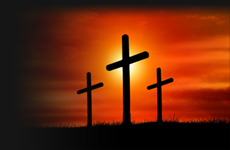Jesus' Crucifixion In Art
The symbol of Christ on the cross has infiltrated culture in innumerable ways, and depictions have become ubiquitous. There is no other subject matter that better reflects the historical progression of artistic expression. This is fitting, as there is no other event that has had comparable effect on all aspects of human history.

"The Crucifixion"
Artist: Paolo Veneziano
c. 1340-1345
Tempera (on wood)
Originally, this painting had an arched top, the contour of which can still be traced in the different appearance of the gilding, which shows that the corners were added much later to transform the panel into a rectangle. Changes like this underscore the fact that early Italian paintings were experienced very differently by their contemporaries than by today’s museum-goers, who are accustomed to single, usually rectangular, paintings hanging by themselves on pristine walls. When artists made these works hundreds of years ago, most were part of altarpieces, and their gold surfaces would have been seen in the flicker of candlelight. Given its shape and small size (some 15 inches high), this panel was probably centered at the top of a triptych.

"Crucifixion of Jesus"
Artist: Hans Memling
c. 1468
Painting
This work is a large antique 15th Century Triptych oil on wood, measuring 56 x 63 cm,

